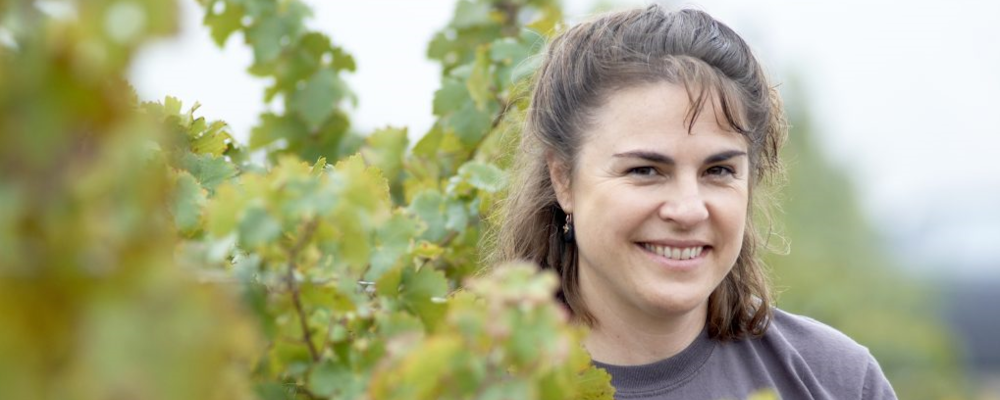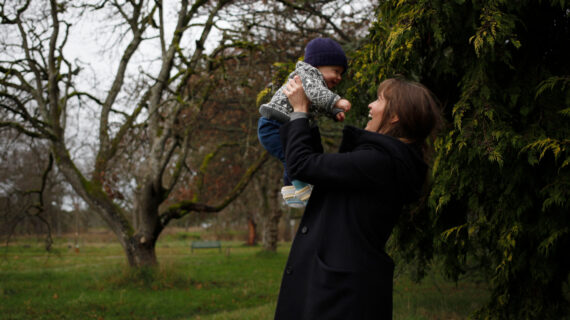Ann Sperling may be best known as the Director of Winemaking Viticulture at Ontario’s Southbrook Farms, although she also makes wine at Sperling Vineyards in BC with her sister and family, and with her fellow oenologist husband, Peter Gamble, at their winery in Argentina. Sperling is also known as a tireless advocate of organic and biodynamic winemaking and was recently named by the Cambridge Food & Wine Society as their 2021 Riedel Winemaker of the Year.
I hadn’t seen or talked to Ann before the lockdown, and the award served as a chance to find out how she came to be one of Canada’s preeminent winemakers. We connected on a Zoom call shortly before Christmas and what follows comes from our conversation.
Sperling grew up with five brothers and sisters in the Okanagan Valley on a farm homesteaded by her great-grandparents. When she was a teenager, her father planted a few rows of Riesling and she became interested in the winemakers that came to the farm to buy the grapes. After earning a degree in Food Science at UBC, Sperling looked into winemaking programs, but found they were “too expensive for a farm girl.”
Instead, Sperling got a job with Andrés Wines, now known as Andrew Peller, which included winemaker training. Sperling credits growing up in a three-generation household for her curiosity and desire to “always dig a little deeper”, traits she says, are rewarded in the wine industry.
Following a foundational six years at Andrés, where Sperling worked for and with a cadre of winemakers who would go on to shape the BC wine scene in the 90s and beyond, Sperling moved over to make wine at Cedar Creek before eventually moving to Ontario.
By the 90s, Sperling was enough of a seasoned hand to begin consulting with the emerging, family-run estate wineries that began to establish themselves in Niagara, helping them get started. She worked with what are now established brands like Cilento and Creekside. She then moved on to Malivoire, taking over from fine wine pioneer Deborah Paskus, who had left the first vintage.
Sperling credits working with Martin and Moira Malivoire as “fun and good, and where it all started”. Since the Malivoire’s lived in the middle of their vineyard, getting it certified as organic was a natural move in more ways than one, and it suited Sperling’s increasing interest in sustainably made wines.
By the mid-2000s, Sperling was working with Bill Redelmeier and family at their fruit and grape winery north of Toronto, Southbrook Farms. The Redelmeier farm, in Richmond Hill, was becoming encroached by suburban development and Bill Redelmeier told Sperling he and his family were interested in selling it and buying land to establish an organic vineyard and winery in Niagara.
Sperling was becoming increasingly interested in biodynamic vineyard management and winemaking: “Conventional, and even organic, can treat the symptoms of a problem in the vineyard, but with biodynamic, the vine becomes part of the environment it’s growing in.” Sperling also had her eye on a few properties around the Niagara Peninsula she thought would work well for that kind of farming, and Redelmeier agreed to tour around with her to take a look at the potential sites.
The last property they looked at is the one where Southbrook is today, on the Stone Road that leads into Niagara-on-the-Lake. They agreed that they would develop it as a biodynamic vineyard, with mixed-use that includes a stand of forest, a pond, and a herd of sheep.
Southbrook, following Redelmeier and Sperling’s vision, would become the first certified biodynamic winery and vineyard certified in Canada, replete with a gold LEED-certified winery complex designed by the renowned Diamond and Schmidt Architects.
In the decade and a half since the move to Niagara, Southbrook’s success has spread. Sperling buys organic grapes for her “non-estate” wines and has been a catalyst for Niagara growers to switch to organic practice. Having grown up on a grower vineyard herself, Sperling is careful who she deals with, looking for more than good sites. She praises her growers as “people who are nice to work with, conscientious, and want to produce the best quality fruit,” adding, “it’s a nice culture that we have developed.
Sperling likes to build success on success, and describes the attitude she shares with her husband, Peter Gamble, as “we can always do one more thing.” (Gamble is a renowned winemaker and consultant in his own right.) Their first project together was Versado in Mendoza, Argentina. They began making wine there in 2008, from hundred-year-old vines that “needed lots of TLC, which [she and Gamble] were happy to provide to get it on a solid footing again.” They set it up so that they had key people to manage the day-to-day work in the vineyard and winery and their influence, as Sperling puts it, would be “in a guiding way.”
Their next project, at Sperling Vineyards in the Okanagan, on the farm where the winemaker grew up, would be in collaboration with her sister Susan Richardson, niece Jill Richardson-Branby, and their respective husbands, Paul Richardson and Rickard Branby. As the pandemic made regular travel difficult, Sperling and Gamble were thankful for their partners in BC and their team in Argentina. They connected across continents by shipping samples and meeting on Zoom when they couldn’t fly. Both vineyards are, of course, certified organic.
Sperling is not just one of Canada’s leading winemakers, she is also one of the country’s preeminent women in wine. She cites pioneer BC winemaker and consultant Lynn Stark as an early example, since Stark would buy her father’s grapes in the early days. But she also explained that the rise of the estate, or family farm, wineries in Canada in the 1980s and 90s meant that women were very much involved in the production of grapes or wine in BC as she came up. She cites George and Trudy Heiss, who established Grey Monk in the early 70s, as friends, neighbours, and inspirations. As she is also to others, undoubtedly, wherever she tends grapes and makes wine.
You can find Ann Sperling’s wines at these websites:
Southbrook: https://www.southbrook.com/
Sperling: https://www.sperlingvineyards.com/
Versado: http://www.versadowine.com/




